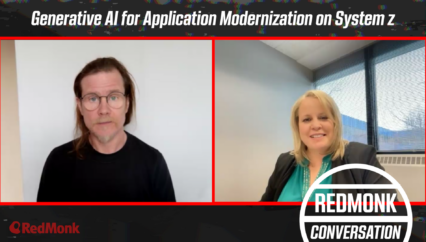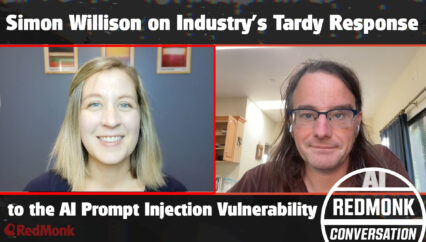Beginning in the 1990’s, the term “edge computing” was used to describe a variety of compute services that were placed geographically closer to end users. In the ensuing decades, the term came to describe an ever broader array of compute services, and the services at the edge became much more robust. In this video, RedMonk and Cloudflare explore what “edge” means today, and how the evolution of edge services is forcing users to rethink what’s possible at the edge.
This was a RedMonk video, sponsored by Cloudflare.
Rather listen to this conversation as a podcast?
Transcript
Stephen O’Grady: Good morning, good afternoon, good evening. I am Stephen O’Grady. I’m the co founder of RedMonk. RedMonk, if you are not familiar with us, is a developer focused industry analyst firm. And we are here today to talk to Rita about a topic that I have some strong feelings on, in terms of edge and capabilities and all that. So, Rita, can you introduce yourself for us?
Rita Kozlov: Sure thing. Hey, everyone, I’m Rita. I’m a senior director of product at Cloudflare. I lead product for our development platform workers as well as our AI initiatives.
Steve: Okay, so, as I said, we’re here to talk edge. And a lot of my strong feelings with edge come from the sort of difficulty in defining it, right? So if we go back a decade ago, it wasn’t that complicated. We had CDNs, and the CDNs had certain capabilities. We were pushing things sort of close to users, and that was kind of it. And in the years since, people have picked up that term and used it in lots of different ways. So I will have conversations with various parties, and they’ll be talking about a rack sitting on a server in an oil rig in the North Sea. Then I’ll talk to somebody else and it’s like, no, my edge is these IoT sensors in a vineyards field, and we still have the CDN. So for me, part of the challenge here is when we’re talking about edge, what are we talking about? Like I said, I won’t go down the rabbit hole. I have my own thoughts and opinions here. But to get to this discussion, when you’re talking about edge, how would you define it? What’s your working sort of baseline?
Rita: You’re not the only one with strong feelings on that word. And the interesting thing, I think Cloudflare is probably one of the companies that’s most associated with edge, and we’re the ones that try to get away from using that term as much as possible, because as you mentioned, it’s kind of taken on so many different meanings. And as you said, it used to be the space that sat somewhere between you have a device and you have a server, and the edge is this thing that’s somewhere in between those two, right, where you can push assets to, and it’s closer to the user. But increasingly, not only has that definition changed in terms of others using it in other ways, but also the capabilities of the edge have changed in such a way that maybe you don’t even need that server, or maybe some of the tasks that previously used to take place on the device don’t need to happen there anymore because there’s more powerful compute nearby. So a couple of terms that we’ve found ourselves gravitating towards more are things like connectivity cloud or distributed cloud that I think help people connect to what we do a little bit better.
Steve: Okay, so you mentioned the capabilities, right. And the capabilities obviously today are sort of a lot different. Right. In other words, we had very limited compute facilities and storage and memory database and all that in years past. So when we are today looking at “edge environments,” do we need to care if we can do things today that we couldn’t 5-10 years ago, however many? Is this something we really need to pay attention to? When you’re talking to customers, users, developers, do they need to care and to what degree do they need to, I don’t know, put any weight or stock in that particular term?
Rita: You mentioned users and developers. And so that’s where I like to start with. And I think that the thing that ultimately as a user or as a developer you care about is the value that you’re actually creating. So as a developer, you want to ship features, you care about shipping good experiences to users, you care about your service being up at all times, you should care about the latency with which your service loads. Right. It’s all about the user to you. Starting with the edge, and is that the thing that you care about? Seems a little bit backwards. And so the way that I prefer to think about it is as a developer you’re going to choose your stack. And so now previously there were certain tools that were available to you and the stack maybe looked like, okay, I’m going to deploy a server somewhere, maybe it’s going to be in a public cloud and I’m going to pick what database I want, what programming languages I want to use ultimately to help me move faster. And I think the edge is getting to a point where we see that more as a part of just the developer stack and actually a way for both developers to move more quickly.
Because there are all of these things that you don’t have to think about configuring anymore, right? You don’t have to think about installing an operating system, upgrading it. You don’t have to think about containers. You don’t have to think about scaling up and then scaling down to make sure that you’re not overpaying for capacity. I think it’s kind of more the inverse of instead of thinking about edge we want to remove all of these things that developers have to think about. And the thing that enables that is being able to deploy things in a way that runs really close to the user in a way that’s infinitely scalable, in a way that allows you to have all of those benefits without really slowing down.
Steve: Okay, so let’s talk capabilities then. So when we think about the edge, the edge is obviously sort of more robust than it was a decade ago, but there are still some limitations. Right? There’s things we can’t do. It’s not a general purpose cloud. So when you talk to folks, how do you sort of ease them through, you can do more, and here are some things that you could do that may surprise you that you couldn’t do before, but also it’s not going to be the place that you run your entire workload. So how do you walk them through that sort of, I don’t know, the triage, if you will, of what runs where.
Rita: Yeah, I think people do tend to today have an association of edge with a very lightweight environment. Which is, again, why that’s something that we’re trying to get away from. And one of the things that we like to start to map out is, okay, well, let’s walk through the stack of your application and what are the different components that it’s made up of today, right? You have some compute that’s running, maybe you have a queue, right? Something like SQS, maybe have a database, maybe you need to be able to run some AI or an LLM. All of those pieces, all of those things are available as a part of Cloudflare’s developer platform today. And so the main shift is in how do you now architect, what are the right tools that are available to you on our platform? But actually all of those capabilities are now available not just on centralized clouds, but on distributed clouds as well.
Steve: Okay, so let’s just dive in very quickly because you mentioned LLMs, and I’m just trying to… can you tease that out for us a little bit? Because I think a lot of people are going to think like, wait, I didn’t realize that you could do that in some of these platforms. So what can you tell us about the capabilities?
Rita: Yeah, as a developer platform, we always love to anticipate developers needs. And if you’re building something right now, if you’re experimenting, you’re almost definitely using AI. And one of the biggest pains that we started to hear about was all of the things that we used to hear about general purpose compute. Right. Especially with GPUs, it’s hard to find available resources right now. It’s hard to scale up because sometimes those resources are unavailable, but at the same time you want to scale down, not to overpay for resources. And so that’s why we announced Workers AI, which actually gives our users access to GPUs running on top of our networks, but with all of the other benefits that we talked about before, just applying those to AI. So whether you’re running LLMs, generating images, creating embeddings, that’s all now available on top of Cloudflare, just with a simple API call.
Steve: Okay, so that makes sense. Just putting this in my words, not yours. It’s almost like edge is then just a feature rather than a thing, right? It’s like, hey, you can do this as well. So if that’s the case, if we can do all these things sort of on these platforms, how are you thinking about this moving forward? Right, when you’re talking to, again, end users, developers, enterprises, what have you, how are you putting it in context? What are you looking to them or what are you telling them to sort of look for in the days ahead?
Rita: I really like the way that you put it in terms of it being a feature, not a thing. And I would take that maybe a little bit further. And the way that I would kind of think about it is most developers are used to thinking in regions, right? One of the things that you pick out first is like US-EAST-1. We don’t talk about US-EAST-1 as a thing. And so our alternative offering to that is like, well, why don’t we let you pick region earth?
Steve: Yeah, okay, well that makes sense, if nothing else, if we can get further away from the term edge, that’s a good thing for me. So I’ll take it. Anyway. Rita, this has been great. Appreciate you stopping by.
Rita: Yeah, sure thing. I really enjoyed it.
Steve: Cheers. Thanks, everybody.




















































































